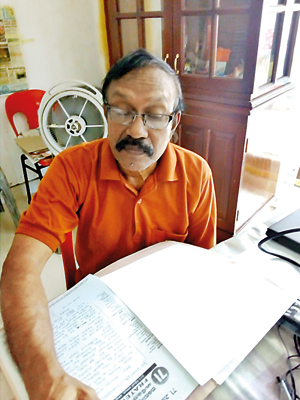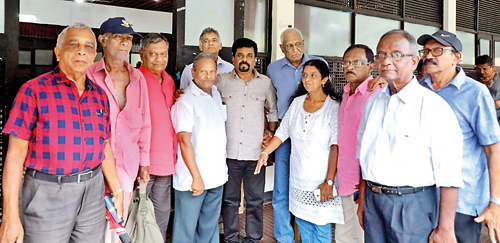Malwatte meetings, where the seeds of a struggle were sown

Youth on the march: JVP leader Rohana Wijeweera (centre) leading from the front. Pic courtesy documentary on Wijeweera by Paul Pieris
Under a spreading tree, ebullient youth gathered in the malwatte. Among them were fresh-faced university students and other young men, all giving ear for five long days, to passionate and eloquent speeches.
Gathering early morn each day after a hasty breakfast and straggling back to their hostels late at night, they absorbed every word, the charismatic and powerful speaker said. He was nondescript in his black trousers and short-sleeved white shirt, with its pus (mould) patches evident, giving an air of unwashed attire.
They knew not who he was, but at the end of the five days of deshana (lectures) and saakachcha (discussions), they were convinced that their beloved motherland needed a new order, where the danapathi panthiya (capitalist class) would not ride roughshod over all others.
They discussed samajawadaya (socialism) and how the so-called socialist parties had attached themselves (mukku gaha-gena) to the two main political parties of the United National Party (UNP) and the Sri Lanka Freedom Party (SLFP).
The clincher was the question – there are 5,000 degree-holders in the rekiya polime (job queue) and do you wish to join them or create a new order?
“Prashnaya saha uththaraya dekama ethana thibba,” says Juana Hennadige Premasiri from Aluthgoda, way down south in Tissamaharamaya who will be celebrating his 72nd birthday on April 13, revisiting his crystal clear memories of early 1969. He was an undergraduate just completing his first year at the University of Ceylon, Peradeniya, where he was pursuing a degree in Political Science, History and Sinhala, occupying Room 13 in the Marcus Fernando Hall.
The declaration from the fired up youth was unanimous and the die was cast in the salubrious climes of the malwatte (the Peradeniya Botanical Gardens).

Looking back: Premasiri today
The seeds for the aragalaya (struggle) were sown – for the first Janatha Vimukthi Peramuna (JVP) insurrection and it would be on April 5, 1971 that the first shots from primitive guns would be fired. A revolt that would fail miserably, petering out like a damp squib, leaving many thousand youth dead!
Tomorrow is the 50th anniversary of the JVP kerella (insurrection), when all those who laid down their lives are commemorated and how their hopes and aspirations can be taken forward.
The malwatte meetings ended with the youth giving their names and gamey addresses and being allocated different areas to work in. When Premasiri was assigned Badulla, he opted for Gampaha (where Athula Nimalasiri Jayasinghe alias ‘Loku Athula’ was the leader) as he had done his Advanced Level from the Batuwatte Maha Vidyalaya (MV), though he was from Tissamaharamaya, living with his elder brother who was working at the Central Mail Exchange in the Fort.
Premasiri’s thoughts flit back to the time before his undergrad (1968 kandayama) days. A clever student also heavily into extracurricular activities, he was appointed the Head Prefect at Batuwatte MV.
The whole Gampaha area including Batuwatte was famous for volleyball and he reminisces how socialist politician S.D. Bandaranayake went around villages setting up youth wings, first by offering volleyballs and nets. The new thinking held the youth in its grip.
The need for a new order was seared into their young minds and so they began enmeshing others and mobilizing them to join up (“kokka gahanawa”).
In 1969, having parted company with his university education, Premasiri headed back to his brother’s home in Gonahena, Kadawatha, and began working in earnest for the movement.
Two adyapana kandawuru (educational sessions) with more lectures and discussions, he attended, one in Elpitiya-Pitigala and the other in Kataragama-Dethagamuwa, where once again his path crossed those of the man in the black trouser and white shirt.
“We were young and robust (nambul tharunayo), needing a lot of food,” he laughs, looking back at how the meals, mainly manioc, were never enough. Whoever sat next to that man would get a few chunks of manioc from his plate.
It was during these workshops that they had a very close encounter with that man – he was none other than leader Rohana Wijeweera sahodaraya.
Premasiri creates images of how the then Colombo district which spanned a large area was demarcated into five under the JVP – Meda Kolamba (the city limits); Dakunu Kolamba (the coastal areas up to Mount Lavinia); Kotte (from Kirullapone to Avissawella); Uthuru Kolamba (beyond the Kelani river to Peliyagoda and Negombo); and Nuwara Paara (from Peliyagoda to Nittambuwa).
The basis of such divisions was the primary unit of an area which was a police station and the ‘JVP Disha Lekam’ (head of the area) of the Nuwara Paara covering Peliyagoda, Kadawatha, Ganemulla, Weliweriya, Kirindiwela, Mirigama, Veyangoda, Gampaha and Nittambuwa) was Jayadeva Uyangoda alias ‘U Mahaththaya’, whom Premasiri replaced.

The JVP thadayo (hardcore) of 1971 pose with party leader Anura Kumara Dissanayake during his election campaign for the Presidency in 2019. In this group photo taken at the Public Library auditorium, Colombo, are (from left): Ampare Nishshanka, Batapola Chandare, Maradana Jayathilake, Bopage Ratnapala, Gamini Habaragamuwa (believed to the youngest JVPer to be incarcerated), Wanathe Osmund, Mala Wijesinghe, Wilfred Anthony, Nuwara Eliye Kapila and Nuwara Paara Premasiri (J.H. Premasiri)
Frenetic preparations were underway with an inadequate number of shot guns and cartridges being collected and bombs being made with ting-kiri tins packed with gelignite. But by 1971, Rohana Wijeweera had been imprisoned and there was an abyanthara dedarimak (internal blast) which fractured the JVP, with the leader’s group comprising Piyathilake, Lionel Bopage and J. Uyangoda ranged on one side and Loku Athula, Sanath Boraluketiya, Kumar Nayake and T.D. Silva on the other.
With a decision being made to launch strikes across the country at police stations on April 4 and then a reconciliatory meeting between the two factions at the Vidyodaya Pirivena on April 2, the strike time was changed for the night of April 5. However, the Wellawaya group of insurgents had jumped the gun, surrounding the police station in the morning instead of the night, simultaneously alerting the state that all was not right with the country .
Scattered across the country, the other knots of youth in their dark blue or black uniforms were in disarray, some attacking police stations but others holding back. Premasiri and his band of youth who were supposed to lay siege to the Gampaha Police Station which had a large contingent of 100 personnel abandoned their quest and slunk into the night. However, his younger brother who was in the attack-group on the Kataragama Police Station had suffered a head injury and been hiding near the Menik Ganga, when he was arrested and later shot by the police when they abandoned this sub-station.
Money was scarce and it was when Premasiri was at the Jaffna Hotel down Hospital Street, in not-so-developed Fort, having remnants of string-hopper pieces and gravy, being given by a hithawathek who was working there, after paying only for a plain tea, that the CID swooped and grabbed him on March 2, 1973.
Earlier, during the Maha Naduwa he had visited Wijeweera in the guise of a lawyer accompanying lawyer M.D. Rathnayake at Welikada and the pets (surathalo) of the state had ratted him out. Taken to the Fourth Floor, he had been only assaulted until he said “yes” he was the “lawyer” who visited Wijeweera, because the CID had collected adequate information on the JVP and already had a file on him.
Premasiri was incarcerated with other JVP thadayo (hardcore) at Fort Hammenhiel on an island close to Kayts, Jaffna. He had been brought to the Magazine Prison during the trial and then taken back to the Jaffna Prison, when with seven others he broke out, to be captured and assaulted mercilessly, the soles of their feet the main targets which have left many with a limp.
With his sentence of 2 years’ rigorous imprisonment (RI) being reduced to 16 months under the Inspector General’s Commission remission and gaining another month of freedom granted on then state head, J.R. Jayewardene’s birthday on September 17, he was home free on that day in 1977. The parting of the ways with the JVP, over differences of opinion, came in 1981.
Tending the small kumburu and goda idam, Premasiri is now the “pan-seeya” (grandfather of five).
The memories of those hot-headed JVP days, however, linger stark and strong, as he says the fundamental flaw which led to the “failed” revolution was not the different timings of the attack on that fateful April 5, 1971, but the lack of support from the masses!



